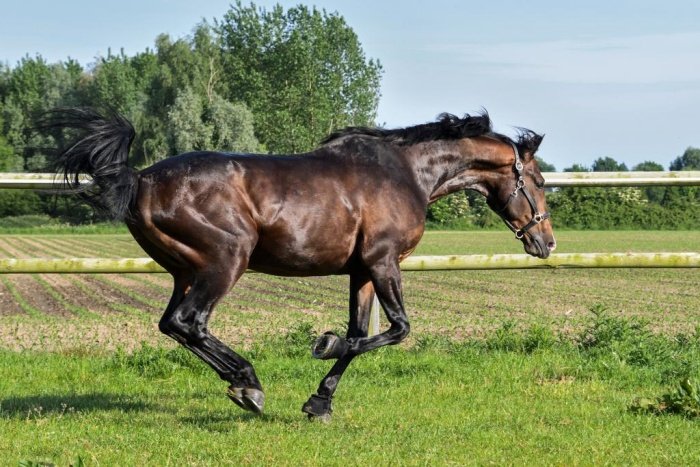How Fast Can a Horse Run?

Horses have been an integral part of human history, captivating us with their beauty, strength, and remarkable speed. The question of how fast a horse can run is not as straightforward as it may seem, as it depends on a multitude of factors that interact in complex ways.
Domestic Horse Speeds
On average, a domestic horse will typically reach a running speed of around 30 miles per hour (mph). However, this is just a general estimate, and with the right training and conditioning, horses can significantly exceed this speed. Thoroughbred racehorses, which are meticulously bred and trained for speed, are capable of achieving speeds upwards of 50 mph. The Guinness Book of Records lists the fastest race speed ever recorded as 43.97 mph, achieved by a Thoroughbred racehorse named Winning Brew in 2008.
The Quarter Horse is renowned for its explosive speed over short distances. It has been recorded at speeds of up to 57.9 mph (92.6 kph), making it one of the fastest horse breeds in the world. This breed's name originated from the quarter-mile races it dominated in the United States. In contrast, Thoroughbreds are better suited for medium-length races, reaching top speeds of around 44 mph (70.9 kph). Arabians, known for their endurance, can maintain speeds of approximately 30 mph (48 kph) over long distances, excelling in endurance riding competitions.
The Impact of a Rider
When a horse is carrying a rider, its speed is generally reduced. A Thoroughbred horse that might reach an average speed of 40 mph (64 kph) without a rider can drop to as low as 20 mph (32 kph) or even slower over longer distances with a rider on its back. The weight of the rider, the rider's skill and balance, and the terrain all play crucial roles in determining the horse's speed. A heavier rider will naturally slow the horse down, while a more experienced rider who can move in harmony with the horse's stride may have less of a negative impact. Rocky or uneven terrain can also cause the horse to slow down to avoid injury and maintain its balance.
Wild Horse Speeds
Wild horses, such as Mustangs, are also known for their speed and agility. While records of their top speeds are less common compared to domestic breeds, the top speed ever recorded by a wild horse was 54 mph (86.4 kph). It's important to note that wild horses have not undergone the same selective breeding and training as domestic horses, yet they still possess impressive speed capabilities. Their speed is a crucial survival mechanism, allowing them to evade predators in the wild.
The Role of Gait
A horse's gait has a significant influence on its speed. The walk is the slowest gait, with a top speed of about 4 mph. It is a four-beat gait where each hoof strikes the ground separately, providing a slow and steady movement. The trot is a two-beat gait that is faster, usually ranging from 8 to 12 mph. In the trot, diagonal pairs of legs move together. The canter is a three-beat gait, with a speed of around 12 to 15 mph, offering a smoother ride. The gallop is the fastest gait, allowing the horse to reach its maximum speed. In the gallop, the horse has a four-beat rhythm, and at its fastest, only one or two hooves are in contact with the ground at a time.
Other Influencing Factors
Beyond breed, rider, and gait, several other factors impact a horse's speed. A horse's conformation, including the length and strength of its legs, the shape of its body, and the development of its muscles, plays a vital role. Longer-legged horses like Thoroughbreds may have a longer stride length, but they may also face challenges in quickly moving their legs back and forth. Muscle development, which can be enhanced through targeted training, is essential for generating power and speed.
Diet is another critical factor. Carbohydrates like oats and barley provide the energy needed for high-performance running. A balanced diet helps the horse maintain a healthy weight, as both overweight and underweight horses will struggle to reach their top speeds. Adequate protein is necessary for muscle development and repair, and vitamins and minerals are essential for overall health and endurance.
Training is perhaps one of the most significant factors in improving a horse's speed. Cardiovascular fitness training helps increase the horse's stamina, allowing it to maintain higher speeds over longer distances. Sprint work and interval training develop specific muscle groups, enhancing the horse's power. Mental conditioning, such as exposing the horse to consistent routines and positive reinforcement, prepares it for the stress of racing. Coordination and balance training enable the horse to use its energy more efficiently, leading to improved speed and agility.
For those looking to optimize their horse's training, the Shinehope Equine Horse Walker can be a valuable tool. This innovative equipment provides a controlled and consistent horse exercise environment. It allows horses to move at a regulated pace, which can be adjusted according to the training goals. Whether it's for warming up before more intense workouts, improving gait regularity, or gradually building endurance, the horse walker machine can contribute to a more comprehensive and effective training regimen.
Conclusion
In conclusion, the speed of a horse is a complex interplay of various factors. From the breed's genetic predisposition to the impact of a rider, the type of gait, and the influence of diet and training, each element contributes to the overall performance. Whether it's for the thrill of racing, the practicality of work, or the simple pleasure of a ride, understanding a horse's speed capabilities and limitations is essential. By providing proper care, training, and attention to these factors, we can help horses reach their full potential while ensuring their well-being and safety. As we continue to study and appreciate these magnificent animals, we gain a deeper understanding of their capabilities and the unique bond they share with humans.